Have you ever heard of V nickels? Are you curious about their worth? Well, you’ve come to the right place. Today’s post is dedicated to telling you all about V nickel value, history, features, varieties, and errors.
V Nickel Details
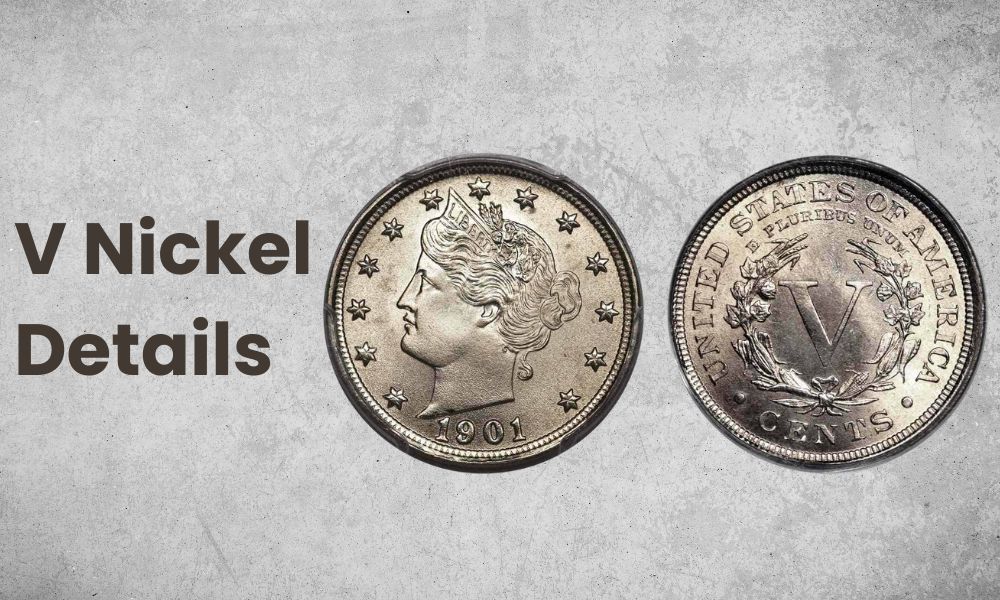
- Category: Liberty Head Nickels
- Total Mintage: 602,086,412
- Minting place: Philadelphia, Denver, San Francisco
- Diameter: 21.2mm
- Weight: 5g
- Edge: Plain
- Face value: $0.05 (5 cents)
- Composition: 75% copper and 25% nickel
- Designer: Charles Barber
The V Nickel’s Obverse Design
The V nickel’s obverse is dominated by a simple image of Lady Liberty’s head facing left. That’s why these coins are also called Liberty Head nickels. On Liberty’s head, the designer placed a coronet with the word “LIBERTY” written on it.
He also placed the date of the coin under Liberty’s neck cutoff, along the bottom rim of the coin. And to top it all off, he put 13 stars around her head, along the top and side rims of the coin. These stars represent the first 13 US states.
The V Nickel’s Reverse Design
This coin’s reverse features a big “V” at its center. This is the Roman symbol for five and was placed there because the face value of the coin is five cents. Ultimately, this symbol is why this coin is popularly referred to as a V nickel.
Around it, there’s a wreath that’s made of cotton, corn, and wheat stalks. Beyond that, the words “UNITED STATES OF AMERICA” are written along the top and side rims of the coin. These words start on the left and end on the right.
When the V nickel was first launched in 1883, the words “E PLURIBUS UNUM” were written along the bottom rim of the coin. These words ran from the left to the right and were in a smaller font than the words on the top/side rims.
However, this inscription was removed from its position later on in the year and placed on top of the wreath, just below the top legend. The word “CENTS” was placed in its original position. Also, a dot was placed on each side of the word.
All coins minted after this change was made had this alteration.
Other Features of the V Nickel
Even though they were minted in different years, all V nickels have the same size, mass, and composition. Each has a diameter of 21.2 mm and a mass of 5 grams. Each also has a plain edge and a composition of 75% copper and 25% nickel.
Also Read: 15 Most Valuable Nickels Worth Money
V Nickel Value Chart
| V Nickel Value Chart | |||||
| Type | Good | Fine | Extremely Fine | Uncirculated | PR63 |
| 1883 V Nickel Without “CENTS” (P) | $7 | $9 | $15 | $18 | $400 |
| 1883 V Nickel With “CENTS” (P) | $20 | $35 | $85 | $120 | $310 |
| 1884 V Nickel (P) | $20 | $35 | $85 | $130 | $310 |
| 1885 V Nickel (P) | $550 | $850 | $1,350 | $1,700 | $1,200 |
| 1886 V Nickel (P) | $275 | $425 | $700 | $825 | $625 |
| 1887 V Nickel (P) | $15 | $35 | $75 | $110 | $310 |
| 1888 V Nickel (P) | $30 | $60 | $175 | $220 | $310 |
| 1889 V Nickel (P) | $15 | $30 | $75 | $120 | $310 |
| 1890 V Nickel (P) | $10 | $25 | $65 | $110 | $310 |
| 1891 V Nickel (P) | $7 | $25 | $70 | $125 | $310 |
| 1892 V Nickel (P) | $6 | $20 | $65 | $110 | $310 |
| 1893 V Nickel (P) | $6 | $20 | $65 | $110 | $310 |
| 1894 V Nickel (P) | $20 | $100 | $240 | $300 | $310 |
| 1895 V Nickel (P) | $6 | $22 | $70 | $115 | $310 |
| 1896 V Nickel (P) | $9 | $35 | $90 | $150 | $310 |
| 1897 V Nickel (P) | $4 | $12 | $45 | $70 | $310 |
| 1898 V Nickel (P) | $4 | $12 | $45 | $75 | $310 |
| 1899 V Nickel (P) | $2 | $8 | $30 | $60 | $310 |
| 1900 V Nickel (P) | $2 | $8 | $30 | $65 | $310 |
| 1901 V Nickel (P) | $2 | $5 | $30 | $60 | $310 |
| 1902 V Nickel (P) | $2 | $4 | $30 | $60 | $310 |
| 1903 V Nickel (P) | $2 | $4 | $30 | $60 | $310 |
| 1904 V Nickel (P) | $2 | $4 | $30 | $60 | $310 |
| 1905 V Nickel (P) | $2 | $4 | $30 | $60 | $310 |
| 1906 V Nickel (P) | $2 | $4 | $30 | $60 | $310 |
| 1907 V Nickel (P) | $2 | $4 | $30 | $60 | $310 |
| 1908 V Nickel (P) | $2 | $4 | $30 | $60 | $310 |
| 1909 V Nickel (P) | $3 | $5 | $32 | $70 | $310 |
| 1910 V Nickel (P) | $2 | $4 | $30 | $60 | $310 |
| 1911 V Nickel (P) | $2 | $4 | $30 | $60 | $310 |
| 1912 V Nickel (P) | $2 | $4 | $30 | $60 | $310 |
| 1912 V Nickel (D) | $3 | $10 | $85 | $175 | N/A |
| 1912 V Nickel (S) | $175 | $285 | $850 | $1,400 | N/A |
| 1913 V Nickel (P) | N/A | N/A | N/A | N/A | $3,172,500 |
V Nickel Value and Varieties Guide
For the most part, V nickels are readily available and affordable to date. This is because a lot of them have high mintages of over 10 million pieces. As such, they will often go for $2 to $175 per piece.
However, there are some dates and varieties that are rare and therefore expensive. Some of these even sell for thousands of dollars. These are the ones we are going to focus on below.
1913 V Nickel (P) Value
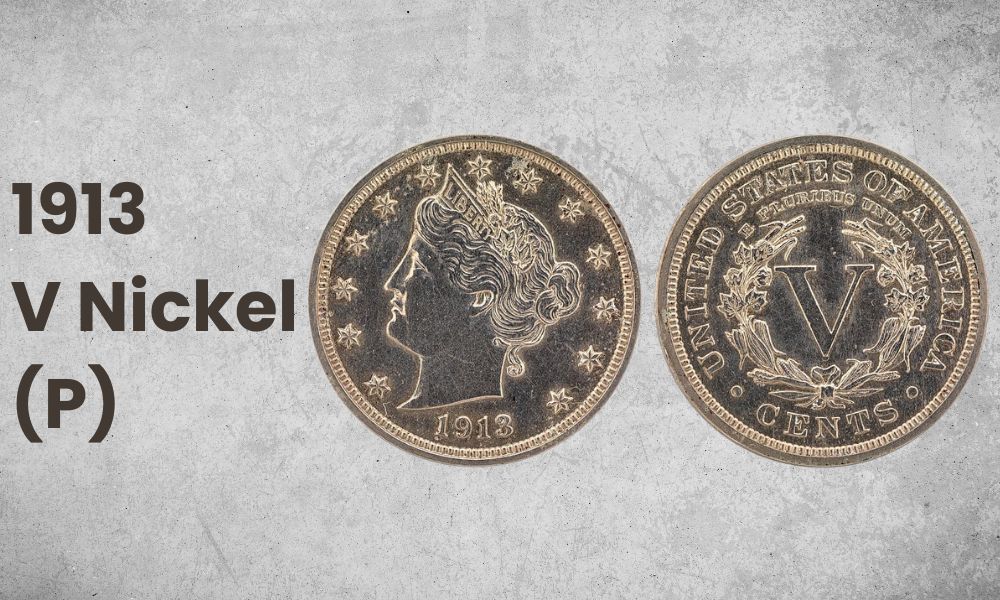
- Type: Liberty Head Nickels
- Mint: None
- Minting place: Philadelphia
- Year: 1913
- Edge: Plain
- Mintage: 5
- Designer: Charles Barber
- Face value: $0.05
- Current value: $3,000,000 to $6,000,000
- %Composition: 75% copper and 25% nickel
- Mass: 5 g
- Diameter: 21.2 mm
There were only five V nickels produced in 1913; these were all proof coins. This is because the production of V nickels was officially halted in 1912. As such, people were shocked when a man called Samwel Brown showed up with these coins in the 1920s.
Since he was a mint employee in 1913, it has always been suspected that he was the one who created them. Whatever the case, these are now the rarest and most expensive V nickels out there.
A PR63 can sell for $3,172,500 while a PR66 can go for $4,560,000.
1912 “S” V Nickel Value
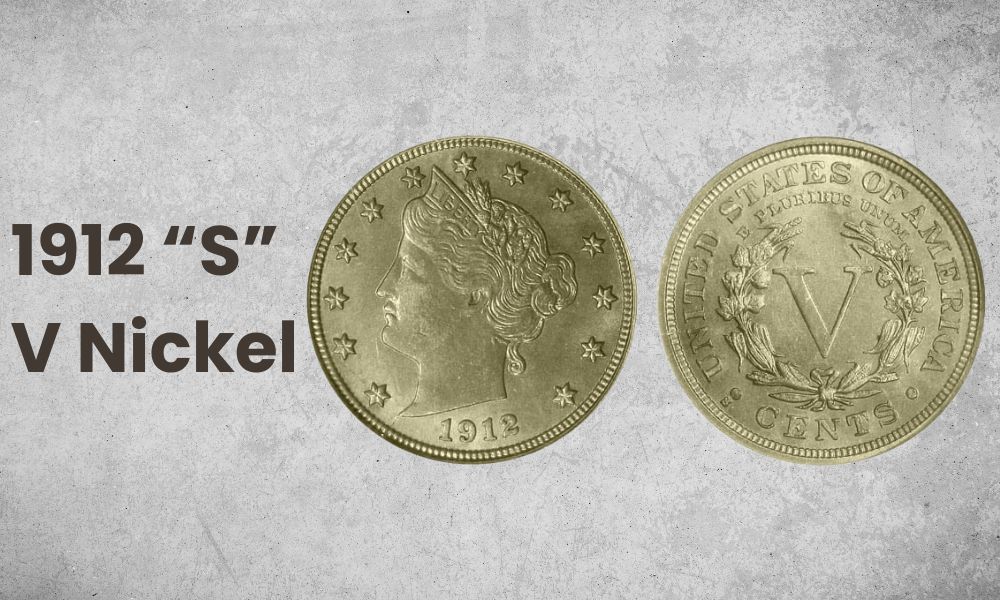
- Type: Liberty Head Nickels
- Mint: “S”
- Minting place: San Francisco
- Year: 1912
- Edge: Plain
- Mintage: 238,000
- Designer: Charles Barber
- Face value: $0.05
- Current value: $175 to $9,900
- %Composition: 75% copper and 25% nickel
- Mass: 5 g
- Diameter: 21.2 mm
1912 was the only year that V nickels were produced in Philadelphia, Denver, and San Francisco mint facilities. V nickels produced in other years were only minted in Philadelphia.
While the Philadelphia mint produced a little over 26 million 1912 V nickels and the Denver mint produced over 8 million, the San Francisco facility produced only 238,000. This is the second-lowest mintage in the V nickel series.
This makes the 1912-S nickel rare and costly. One of these nickels in the good grade can go for $175 while an MS62 can go for $1,400. On the other hand, an MS66+ can cost as much as $9,900.
To tell if a 1912-S V nickel is genuine, look for an “S” mint mark on the reverse side of the coin. This mark is usually located under the dot between the word “CENTS” and “UNITED”.
The coins minted in Denver have a “D” mint mark instead while the Philadelphia ones have none.
1885 V Nickel (P) Value
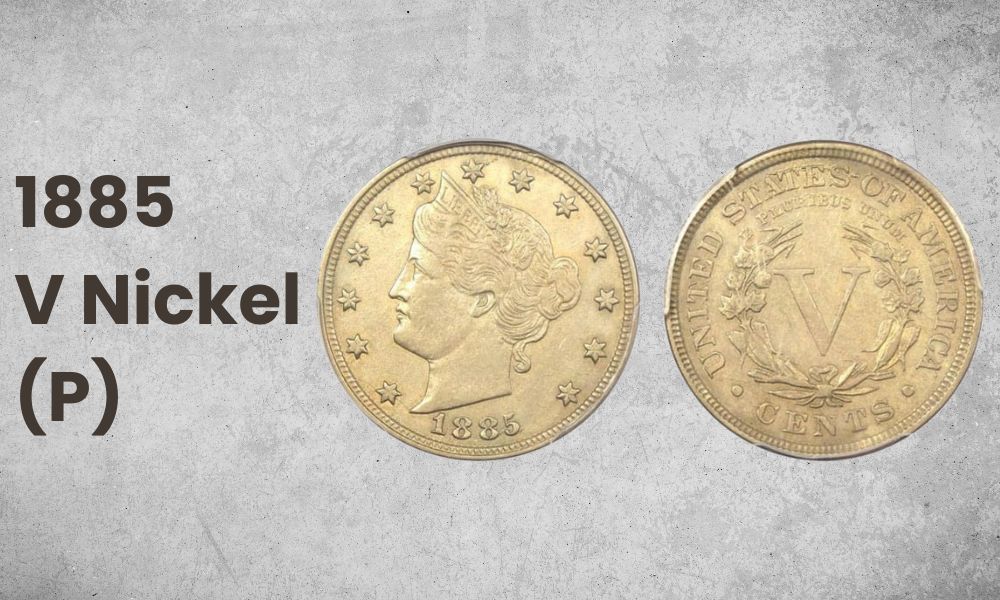
- Type: Liberty Head Nickels
- Mint: None
- Minting place: Philadelphia
- Year: 1885
- Edge: Plain
- Mintage: 1,476,490
- Designer: Charles Barber
- Face value: $0.05
- Current value: $550 to $40,000
- %Composition: 75% copper and 25% nickel
- Mass: 5 g
- Diameter: 21.2 mm
In 1885, the Philadelphia mint produced 1,476,490 V nickels; this is the third-lowest mintage of the series. These were the only nickels minted that year and none of them had a mint mark. But 3,190 of them were proof coins.
Because 1885 V nickels are rare, they usually go for $550 to $40,000 per piece. An MS67 regular strike has even gone $74,750 at an auction before. However, proof coins are particularly cheaper than regular strikes in this category.
They usually go for $720 to $20,000 per piece.
1886 V Nickel (P) Value
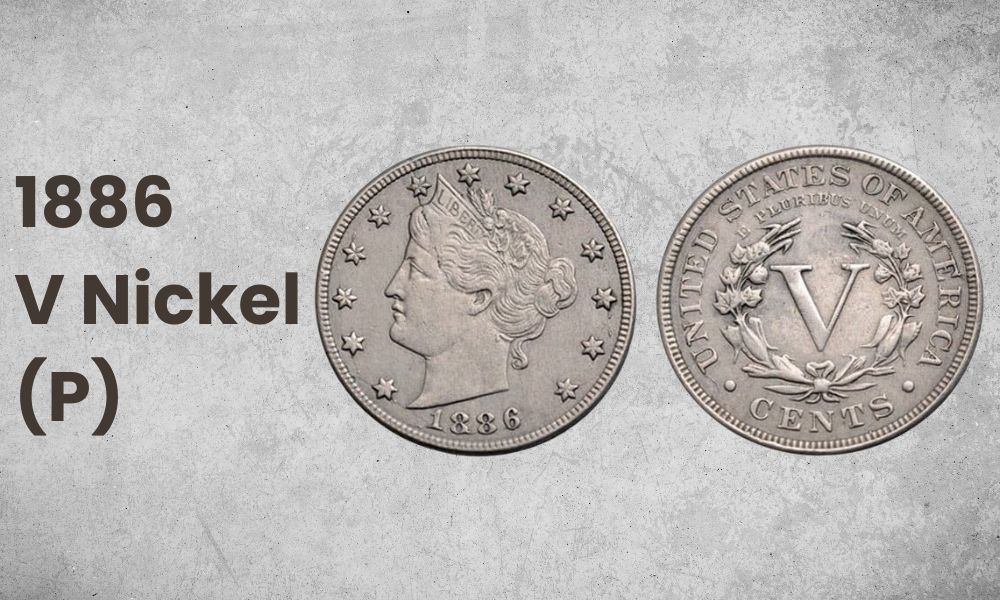
- Type: Liberty Head Nickels
- Mint: None
- Minting place: Philadelphia
- Year: 1886
- Edge: Plain
- Mintage: 3,330,290
- Designer: Charles Barber
- Face value: $0.05
- Current value: $825 to $75,000
- %Composition: 75% copper and 25% nickel
- Mass: 5 g
- Diameter: 21.2 mm
In 1886, the Philadelphia mint produced 3,330,290 V nickels; this is the fourth-lowest mintage of the series. These were the only nickels minted that year and 4,290 of them were proof coins.
The regular strike coins usually cost $825 to $75,000 per piece depending on grade. Interestingly, proof versions are cheaper. A PR63 costs around $625 while a PR68 can cost $18,600.
Also Read: Top 110 Most Valuable Nickels Worth Money
V Nickel History
The V nickel was first minted in 1883 and was officially minted every year until 1912; the production in 1913 was unauthorized. Keep in mind that V nickels were designed by the then chief engraver of the mint Charles Barber in 1882.
Interestingly, his first designs weren’t accepted by the then Treasury Secretary Charles Fogler. This is because the obverse design had a legend with the words “UNITED STATES OF AMERICA” along the top and side rims.
On the other hand, the only words on the reverse were“E PLURIBUS UNUM” along the top rim. This was a problem because the law only allowed the words “UNITED STATES OF AMERICA” to appear on the reverse of the coin.
This forced Barber to place them along the reverse’s top rim and move the “E PLURIBUS UNUM” inscription to its bottom rim. That’s when the 13 stars were introduced to the obverse design.
However, Lady Liberty’s image, the date inscription, the V image, and the wreath elements all remained the same. Ultimately, this design was quickly approved and began being minted in early January 1883.
But fraudsters started using this coin for illegal activities. Since it didn’t have the word “cents” on it and was almost the same size as the half dollar, they began gold plating it and passing it on as such.
When the mint found this out, it stopped producing V nickels and had Barber modify his designs. This is when he placed the word “CENTS” on the reverse’s bottom rim and moved the “E PLURIBUS UNUM” directly above the wreath.
This modified coin was released in June 1883. As a result, some people started hoarding the original coins, especially since they had heard that the mint would recall them. Whatever the case, the modified design was used until the V nickel was discontinued.
V Nickel Grading
When grading V nickels you will have to look at the details in Lady Liberty’s hair and the stars in the obverse design. You will also have to look at the details of the V, wreath, and words on the reverse.
To effectively do this, you need training. That’s why it’s always best to leave this work to professional agencies like NGC and PCGS.
List of V Nickel Errors
V Nickel Broadstruck
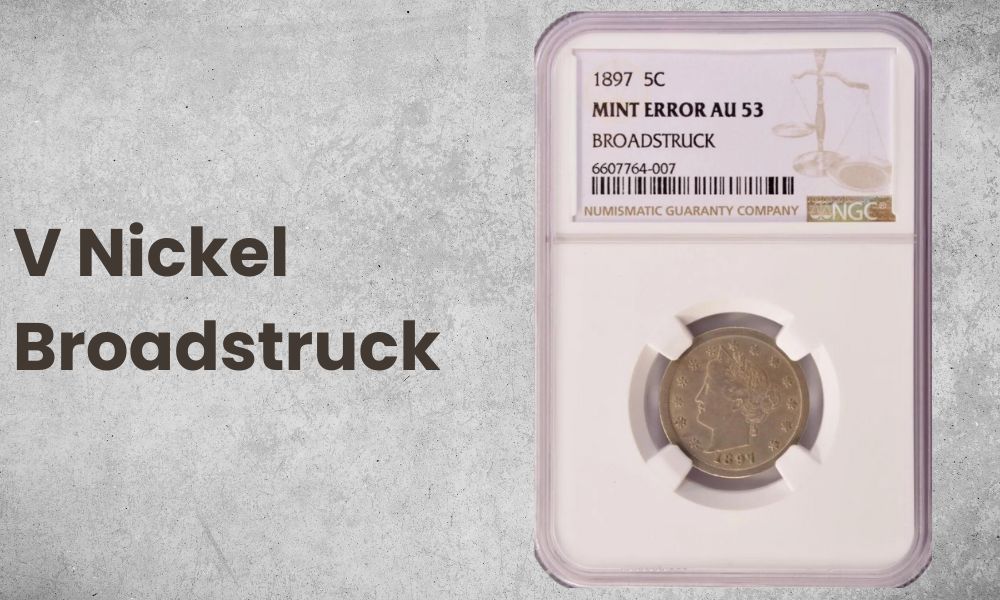
A broad strike error occurs when the mint strikes a coin out of the retaining collar but in a centered way. This makes the coin spread out farther than it usually does. This error is valuable, even in V nickels.
A PCGS MS62 1912-D nickel with this error can sell for over $430. An NGC F12 1912-S nickel one can go for $630.
V Nickel Lamination
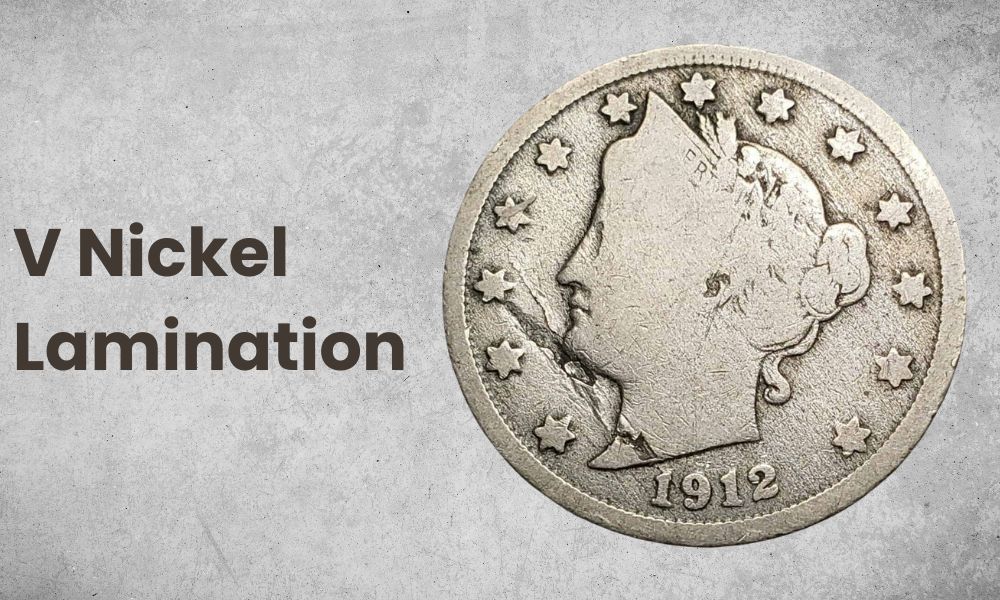
A lamination error is evidenced by places in the coin where some metal has peeled off or detached. Its main cause is the presence of impurities in the metal used to create the planchets.
It’s a valuable error that can make your V nickel more expensive. An NGC VG10 1912-S nickel with this even error sold for over $200.
V Nickel FAQ
Is there silver in V nickel?
No, V nickels don’t contain silver. They only have copper and nickel.
What is the most valuable Liberty V nickel?
The 1913 nickel is the most valuable V nickel; one costs 3 to 6 million. This is because it’s the rarest V nickel out there.
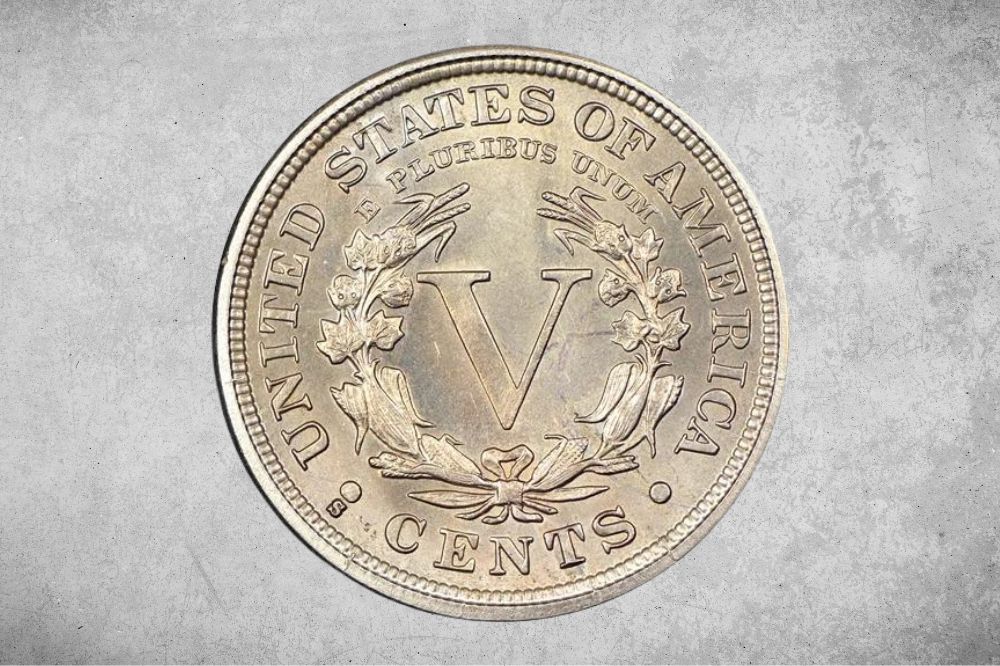
ok,it is good diea
it can help me